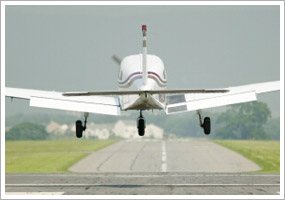
The following stories from the August 1, 2008, edition of AOPA ePilot were provided to AOPA members who expressed an interest in the particular subject areas. Any AOPA member can receive information tailored to their areas of interest by updating their preferences online.
| My ePilot Training Tips |
| THE WHEELBARROW Less recognized because of its less-spectacular symptoms is the problem of wheelbarrowing. But to anyone who has spent time pushing a real wheelbarrow, the term authentically depicts an airplane speeding along the runway with its nosewheel planted too firmly on the ground and its tail surfaces and main gear constrained from performing their functions. That's why it's worth taking some time to understand wheelbarrowing, its causes, and its possible results. "Normally, 'wheelbarrowing' may be encountered if the pilot is utilizing excess approach speed in a full flap configuration that results in the aircraft touching down with little or no rotation," explains an FAA advisory circular. "After this touchdown, the pilot may then try to hold the aircraft on the ground with forward pressure on the control wheel. Under these conditions, braking and steering capability is severely diminished and 'wheelbarrowing' is likely to result." This is particularly so in crosswind conditions. Wheelbarrowing is a takeoff hazard as well. Note that the effect "can occur at lower speeds than during landing due to the propwash increasing the lifting power of the horizontal stabilator. The use of excessive forward stick pressure during takeoff to hold the airplane on the ground to speeds above normal takeoff speed is not recommended," adds the advisory circular. When landing, a good roundout is always the proper first step. It's also insurance against the wheelbarrow because it sets you up to touch down in the correct nose-up attitude, as Tom Horne explains in "Touchdown" from the September 2003 AOPA Pilot . Another resource for studying the wheelbarrow phenomenon, and how to steer clear of it, is the discussion in Chapter 8 of the Airplane Flying Handbook . Note the proper and simple wheelbarrow-repair techniques given: Smoothly apply back-elevator pressure, or, if it's too late for that, go around! |
| Training Products |
| 'DAMIAN DELGAIZO'S TAILWHEEL 101' Note: Products listed have not been evaluated by ePilot editors unless otherwise noted. AOPA assumes no responsibility for products or services listed or for claims or actions by manufacturers or vendors. |
| My ePilot Final Exam |
| Question: What is density altitude, and how does it affect aircraft performance? Answer: Technically speaking, density altitude is pressure altitude corrected for nonstandard temperature and pressure. Simply put, it's a term used to describe the expected performance of an aircraft at a given temperature and altitude. On a standard day, at sea level, the outside air temperature is 15 degrees Celsius (59 degrees Fahrenheit) and the atmospheric pressure is 29.92 Hg. However, as temperature increases the air density thins and, as a result, aircraft performance deteriorates. The higher the altitude and temperature combination, the thinner the air and the worse the aircraft will perform. A density altitude of 3,000 feet at sea level means an aircraft will perform as if it actually was 3,000 feet above sea level. A high density altitude translates to less power output, decreased lift, and decreased propeller efficiency, resulting in needing significantly more runway to achieve liftoff and obstacle clearance. Read more in AOPA's subject report. If you're flying in the mountains where the effects of density altitude are pronounced, take the AOPA Air Safety Foundation's Mountain Flying online course. Got a question for our technical services staff? E-mail to [email protected] or call the Pilot Information Center, 800/872-2672. Don't forget the online archive of "Final Exam" questions and answers, searchable by keyword or topic. |
 What do a porpoise and a wheelbarrow have in common? An airplane can do a convincing imitation of either when problems crop up during ground runs. Touching down in an improper attitude, with too high an airspeed and rate of descent, famously leads to porpoising and accidents involving pilots in training. Learn more about porpoising in the April 16, 2004, "
What do a porpoise and a wheelbarrow have in common? An airplane can do a convincing imitation of either when problems crop up during ground runs. Touching down in an improper attitude, with too high an airspeed and rate of descent, famously leads to porpoising and accidents involving pilots in training. Learn more about porpoising in the April 16, 2004, " 

